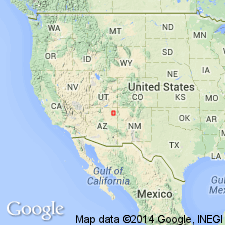
- Usage in publication:
-
- Rough Rock Sandstone*
- Modifications:
-
- Named
- Dominant lithology:
-
- Sandstone
- AAPG geologic province:
-
- Black Mesa basin
Summary:
Named as a formation in the Mesaverde Group for exposures 3.5 mi (5.6 km) southwest of town of Rough Rock, Apache Co, AZ in Black Mesa basin. These exposures are located at 36 deg 32' 22" Lat N; 109 deg 54' 49" Long W, and are designated the type section. They were formerly mapped as the upper sandstone member of Toreva Formation. Extends across the northern Black Mesa as a sheet-like, cliff-forming, moderately to well sorted, subround, very fine to medium grained, grayish-orange to yellowish-gray sandstone. Thins from 105 ft (32 m). There is no subsurface extension of Rough Rock beyond the mesa because of Tertiary erosion. Is 90+ ft thick at type where it gradationally overlies Wind Rock Tongue (new) of Mancos Shale and conformably underlies upper carbonaceous unit of Wepo Formation. Is dominantly a subarkose to sublitharenite. Contains less feldspar and more chert than underlying Toreva. Is a marine unit deposited during a period of shoreline progradation. Has abundant OPHIOMORPHA barrows (indicates tidal inlet or tidal channel origin). Has no age diagnostic fossils but regional evidence indicates deposition occurred during the R-3 regression in late early to middle Santonian, Late Cretaceous time.
Source: GNU records (USGS DDS-6; Denver GNULEX).
For more information, please contact Nancy Stamm, Geologic Names Committee Secretary.
Asterisk (*) indicates published by U.S. Geological Survey authors.
"No current usage" (†) implies that a name has been abandoned or has fallen into disuse. Former usage and, if known, replacement name given in parentheses ( ).
Slash (/) indicates name conflicts with nomenclatural guidelines (CSN, 1933; ACSN, 1961, 1970; NACSN, 1983, 2005, 2021). May be explained within brackets ([ ]).

